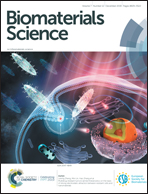Anti-biofilm surfaces from mixed dopamine-modified polymer brushes: synergistic role of cationic and zwitterionic chains to resist staphyloccocus aureus†
Abstract
Infections resulting from the attachment of bacteria and biofilm formation on the surface of medical implants give rise to a severe problem for medical device safety. Thus, the development of antibacterial materials that integrate bactericidal and antifouling properties is a promising approach to prevent biomaterial-associated infections. In this study, two types of dopamine-modified polymers, dopamine-terminated quaternary ammonium salt polymer (D-PQAs) with various lengths of N-alkyl chain (D-PQA4C, D-PQA8C, and D-PQA12C) and dopamine-terminated poly(sulfobetaine methacrylate) (D-PSBMA), were synthesized via atom transfer radical polymerization (ATRP). Mixed polymer brushes of D-PQAs and D-PSBMA with various ratios were well-integrated onto the surface of a silicon wafer via a facile mussel-inspired adhesion. We demonstrate that the synergistic antibacterial effect depends on both the ratio of the two components and the surface structures of the mixed polymer brushes, originating from the interactions between D-PQAs and D-PSBMA. The N-alkyl chain length of D-PQAs influenced the distribution and orientation of the alkyl chain on the mixed polymer brushes. A chart of the antibacterial efficiency of the mixed polymer brushes was obtained to reveal the synergistic role of their cationic and zwitterionic chains to resist S. aureus. The dominant amount of antifouling D-PSBMA with a minor amount of bactericidal D-PQAs with a short N-alkyl chain length facilitated the synergistic antibacterial effect. The selected polymer brushes (PSBMA/PQA4C-10%, PSBMA/PQA4C-30%, and PSBMA/PQA8C-10%) could effectively prevent biofilm formation by S. aureus for a long time, while having good biocompatibility. This work may provide a universal design strategy for the preparation of anti-biofilm and biocompatible surfaces for biomedical applications.



 Please wait while we load your content...
Please wait while we load your content...